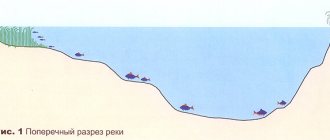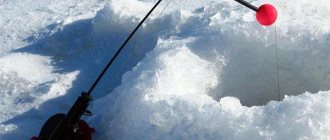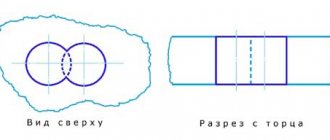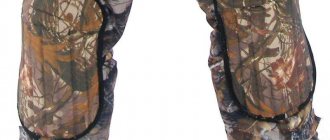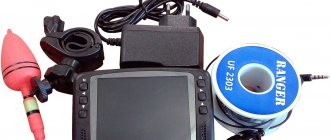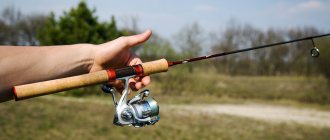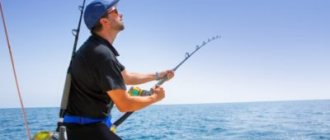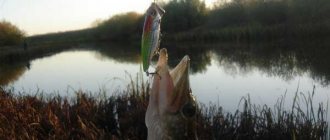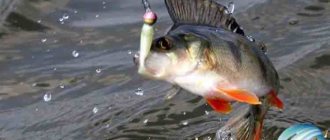Winter fishing is characterized by the fact that before leaving you need to think carefully about your equipment.
The main attention should be paid to warm clothes, otherwise you can easily freeze in a pond, which will lead to hypothermia. The results of hypothermia may be disappointing and you may spend the near future at home in bed with a fever. When choosing clothes, you should pay attention to the following factors:
- High heat retaining properties.
- Wind protection.
- Removal of excess moisture.
Among other things, clothing should be comfortable and have a modern, practical cut.
Winter clothing for fishing and its features
When choosing clothes for winter fishing, you should immediately pay attention to the material from which it is made. As a rule, materials of artificial origin are considered the most practical. They are much more resistant to moisture, remove it better and dry faster if they get wet.
Winter clothing is made from the following materials:
- Polartek . It is one of those materials that dry quickly. In addition, it has good thermal insulation properties. Despite these advantages, this material has one drawback - it does not protect well from the wind. In this regard, Polartek is perfect for making “inner” clothing.
- Reinforced stretch . This is a combination of Polartec and Lycra. This combination of materials is perfect for sewing winter outerwear, including fishing ones. The material has antibacterial properties.
- Windblock . Refers to a variety of fleece. This material, in all its characteristics, is perfect for the production of winter outerwear, so necessary for winter equipment. Clothing made from this material retains heat well, absorbs and quickly releases moisture, while retaining heat. Among other things, the windblock is quite soft and pleasant to the touch material.
- Outlast is considered a rather interesting material that is capable of accumulating heat in its structure. After active activity, the material begins to give off heat, optimizing heat exchange.
- Thinsulate is a modern filler that is used when sewing winter clothes. This filler is able to retain heat, which means it can protect against cold.
- Membrane fabrics are also widely used when sewing warm clothes.
How to choose the right winter fishing suit?
With the onset of cold weather, fishermen begin to pay special attention to the choice of equipment. A winter fishing suit purchased once will allow you to avoid the “cabbage” principle. Clothing for fishing should be as comfortable and convenient as possible, and in winter, serve the function of preserving body heat. Most often, a large amount of clothing only hinders the fisherman, but does not provide the necessary heat transfer. Therefore, in order for the movements to be relaxed, it is better for the fisherman to give preference to special clothing.
Recommendations for choosing winter clothing for fishing
How to dress properly for winter fishing [salapinru]
When choosing clothes for fishing, first of all, you should think about comfort. Fishing will be comfortable if the clothes are comfortable, and this depends on how well the equipment is chosen. Previously, all fishermen dressed according to the “cabbage” principle, which meant the number of layers of clothing. The more layers, the warmer, but nowadays it is enough to wear thermal underwear, a fleece suit and outerwear in the form of warm trousers and a jacket.
And now, about these layers of clothing, in more detail.
- Underwear thermal underwear . The purpose of thermal underwear is to fit tightly to the body and remove excess moisture. After all, winter fishing involves active physical movements associated with setting up a camp or drilling holes, as well as other activities. As a result of physical exertion, the fisherman necessarily sweats. If moisture is not removed in time, the person will begin to freeze and you can immediately forget about comfort. After physical exertion, there comes a period when the angler does practically nothing, but just sits near the hole. In this case, thermal underwear should ensure heat retention. Due to the fact that moisture is quickly removed, an air gap is created, which retains heat.
- Fleece suit . This is a light and soft material that also wicks away moisture and retains heat. Fleece is an excellent intermediate material between underwear and warm outerwear.
- Outerwear . Pants with straps are the best option because they can protect your back from the cold. The back is considered one of the most vulnerable parts of a fisherman's body. The most suitable material for sewing outerwear is membrane fabric. Since such materials quickly lose their characteristics, they must be washed in a special liquid.
Protection of body parts
The comfort of fishing will depend on how protected all parts of the body are. At the same time, it is meant that it is necessary to protect the back, head, arms, legs, knees, etc. Fishermen quite often kneel down and spend a lot of time in this position. Special knee pads are sold to protect the knees. They very effectively protect the knee joints from hypothermia and from unnecessary stress. After all, the knees are considered one of the most important parts of a person’s legs. Their protection is mandatory.
It is equally important to protect your hands, as well as your fingers, especially since they have to be manipulated very often. There are special gloves with “flip fingers” for this purpose. This is very convenient, especially since you regularly have to put bait on the hook.
Temperature conditions
Clothing from different manufacturers is produced for different temperature conditions. The Latvian company NORFIN develops winter outerwear that can withstand temperatures down to -30 degrees. Domestic produces clothing that can withstand low temperatures down to -25 degrees.
Do you need a fitting?
The answer is clear - you need to try on clothes. It is very important that it is sewn exactly to size, to fit the body, but at the same time not to interfere with movements. Clothes that are larger and “hang” on a person will not be able to retain heat.
Review of winter fishing suits
HOW TO DRESS CORRECTLY IN WINTER (Valery Sikirzhitsky)
It’s already the 8th winter season since I completely “changed” into Norfin .
And now nothing will make me return to forgotten sweaters and quilted jackets. The difference between modern “breathable” clothing and obsolete clothing is so significant that it affects the entire fishing experience as a whole. After all, if, say, in the summer equipment is not so important, then in the winter season it comes out almost in first place in importance. And, not knowing how or not wanting to dress properly, many give up ice fishing altogether. I remember that about 15 years ago, for me, a frost of -7 was already considered significant, and then I would have really thought about whether to go fishing. Now I don’t pay much attention to the air temperature, as well as precipitation, wind strength and other weather characteristics - in any case, I know that I will feel comfortable. Because he is dressed in the “correct” Norfin !
I used the word “correct” for a reason - it is important not only to choose modern clothes of a particular brand, but also to use them correctly. Only then will you fully experience all the positive qualities of your equipment.
There is a common concept of “layering concept” in clothing. It includes three layers, each of which performs its own main function. However, I will not go into descriptive details of this concept, but will talk about how I dress in the winter season. Moreover, I do it “according to science,” that is, following the layer-by-layer concept mentioned above.
It all starts with thermal underwear. This underwear must be worn on the body. I am often asked: “Which underwear is better to take – thin or thick?” I answer unequivocally: “Both!” Thin thermal underwear alone is usually not enough to perform the functions of moisture removal and warming. But only in a thick one, when you put it on a naked body, you may not feel very comfortable.
Thin underwear should fit snugly on the body and perform the main function of wicking away moisture during activity. In general, the concept of “subtle” is quite arbitrary. Often my bottom layer is Comfort Line underwear, which can be classified as medium in density. I put it on my body in fairly cold weather. So, I would rather call this underwear underwear. Accordingly, a little later the concept of “outer thermal underwear” will appear.
The other two underwear that I have in my wardrobe - Thermo Line and Active Line - also find a place in winter gear depending on the weather conditions. I wear them at higher air temperatures or when constant activity is involved, for example, when fishing for pike with balance beams. Active Line underwear is well suited for long trips with overnight stays in the car or outdoors, when you have to be dressed for several days in a row. It is made of hypoallergenic material that fits perfectly to the body. In addition, thanks to silver ions, the natural bacterial balance of the skin is maintained.
If I can alternate the model of lower thermal underwear, but the upper one remains unchanged - this is Norfin Cozy Line . Paired with thin underwear, it continues to perform the function of removing moisture from the body, maintaining a constant temperature and comfort. In addition, thick underwear already performs a warming function. Very often I only wear two sets of thermal underwear under my outer suit. This happens in mild frosts, in the absence of strong winds and precipitation, and also when you are supposed to be on the move during your entire fishing trip—at competitions or while actively searching for fish.
In other situations I also use the middle, so-called insulating layer. Ideally, it should also be “breathable” so as not to interfere with the removal of moisture from the body, but still its main function is warming.
The middle layer is often a “breathable” Vest vest, made from Norfin – Nortex Breathable . The sleeveless jacket has a high collar that protects the throat well from the wind, zippered pockets, and a separate pocket for a mobile phone. Considering that in an outer suit the “mobile phone” constantly freezes and turns off during winter fishing, I use the special pocket in the vest quite often.
Now Norfin has also released a fleece vest - the River model, which is also worth paying attention to. Such sleeveless vests are good because they do not restrict the movements of the arms and are easy to put on an outer suit - its sleeves go on freely.
However, I also wear fleece jackets quite often. For example, the top of a Polar Line fleece suit is slightly cooler than a Norfin Vest and is sometimes better suited to fishing weather. In general, I choose what to wear as a middle layer, first of all, according to weather conditions, as well as the expected activity. Having several models of insulating clothing available, this is easy to do.
Sometimes, over two sets of thermal underwear, you also have to wear pants from a Polar Line or Polar Line Camo . We are talking about frosty weather and (or) strong piercing wind. The latter often happens when spinning fishing from a boat in late autumn. The activity during this kind of fishing is minimal, so you have to be properly insulated. It turns out that in pre-winter boat spinning I use the middle warming layer even more often than when fishing from ice.
Finally, I put on my outer suit over the first and second layers of clothing. At the moment I have two main options - Norfin Arctic and Norfin Extreme 3 . Both are designed to protect from wind and precipitation, and, of course, also keep warm.
The popular Norfin Arctic suit has served me faithfully for a full 5 seasons and I have no particular complaints about it. This is what a “folk” model means! But since I do winter spinning and often get caught in rain or sleet, there was a need for a suit with better water resistance. Extreme 3 became such a replacement for “Arctic” . However, not a replacement - in the cold season I use both of them in turn, choosing, again, for weather conditions and the type of fishing. Each of the two costumes has its own characteristics.
The Norfin Arctic suit is lighter; I use it more often for sea fishing. It has a comfortable, in my opinion, hood, a “warm collar”, long cuffs that partially replace gloves. I would also like to note the waterproof inserts on the knees and internal snow gaiters. I always use them, tucking the inside into my boots, and putting the galosh itself, equipped with a zipper and a Velcro flap, over the shoes.
The Norfin Extreme 3 suit is made of denser, windproof material and has inserts on the knees and back. I use it more often in inclement cold weather. At the same time, good “breathing” ability is 6000 g/m2. m/24 hour – allows you not to be afraid of active movements. Taking into account the work of the first layer of thermal underwear, the moisture will be successfully brought to the outer suit and will come out. Particularly worth noting is the warm detachable jacket - I often use it separately, including when not fishing.
Another thing I like about the Extreme 3 is the side pockets. Firstly, they come in overalls, which is very convenient when you walk without a jacket. Secondly, they are deep: when balancing fishing, I put everything I need in them - a detacher, extractor tongs, scissors, a navigator, spare leads, etc. You can even add an extra fishing rod! As a result, you don’t have to carry a box or a backpack - and at the same time, everything is at hand.
However, interesting advertising does its job (we are talking about the “ Norfin Discovery on the Moon” module, which adorned the stand at the exhibition in Moscow), and on the eve of the next winter season I looked for a new suit. Norfin Discovery has the same declared waterproof and breathability ratings as Extreme 3 – 6000 each, which is very good. Plus, the Hollofil insulation should provide the suit with good warming ability. In general, I am sure that it will be warm, dry and comfortable. As has always been the case since I started dressing in Norfin . Of course, under the obligatory condition - no additional tights or sweaters, only the right winter clothes!
Which company to choose a suit for winter fishing
There are many manufacturers of fishing clothing, but there are also those that have proven themselves only on the good side.
NORFIN
Clothing under this brand is produced in Latvia. The manufacturer develops and produces the entire line of both clothing and shoes. Therefore, there is no need to assemble the suit in parts from different manufacturers. Clothing and footwear from this company, produced for fishing, meets the most modern quality requirements.
RYOBI
These clothes, made of membrane fabric, are produced in Japan. The Japanese manufacturer is interesting because it is constantly in a state of new developments using modern technologies. RYOBI winter clothes do not allow moisture to pass through, protect from the wind and keep warm well. The winter suit includes a jacket and high trousers that protect the lower back and back. Internal pockets are insulated, and external ones are equipped with waterproof zippers.
DAIWA
The clothes of this company also represent Japan. During the production process, the company exercises total control over the quality of its products. By purchasing winter clothes from this company, you can be sure of the high quality of the products. All products meet the highest modern requirements:
- Wear resistance.
- High protection.
- Thermal insulation.
- Comfort in any conditions.
IMAX
Winter clothing under this brand represents Denmark. In the production of clothing, membrane fabrics are used that breathe well and allow air to pass through perfectly. Due to the fact that a special tensulate filler is used in production, the clothing is characterized by excellent thermal insulation properties. In such equipment you can feel comfortable even at temperatures of -40 degrees.
Nova Tour
The clothing of this Russian company is considered the most popular on the domestic market. All clothing models are designed and produced by people who are familiar with the harsh winters of Russia. The weather is very changeable, but winters can be particularly harsh. Winter equipment can protect you from severe frosts, hurricane winds and heavy rainfall.
RAPALA
Finns make winter clothes with this brand. As a rule, it is distinguished by excellent quality and modern design. Winter clothing sets are designed for conditions with temperatures below -30 degrees. The clothes show enviable characteristics of wear resistance and heat retention.
Main characteristics
A fishing suit has three main characteristics: the temperature for which it is intended, steam conductivity and water resistance. You should absolutely not buy a suit that has not been tested and for which these indicators are not standardized. It is worth describing them in order.
Temperature
Usually indicated in degrees. The figure shows how comfortable it will be for a person wearing this suit to go out into the cold from a warm room and stay there for no more than 2-3 hours.
The influence of wind and air humidity are not taken into account. Accordingly, in order to fish at -20 degrees in a strong wind in the Gulf of Finland, when the humidity is high, you should wear a suit at least designed for -45. It is also worth considering here that the suit is selected based on the night temperature, and not the daytime temperature. Usually, when they go fishing, they take a suit with a double reserve; if the forecast is -10 at night, it’s worth putting on a suit for -20.
Steam conductivity
One of the most important characteristics. Shows how much a person can sweat and move actively in this suit. Good vapor permeability is ensured by high-quality membranes. Measured in ml/sq.m per 24 hours. Usually a good suit has a vapor permeability of 3000-5000. This means that per day a square meter of such a suit passes 3-5 liters of water from the body.
Under normal conditions, a person secretes about half a liter of sweat per day; during active exercise, such as fishing, up to two liters.
The increased indicators indicate that with a short-term increase in load, for example, when drilling a series of holes, the suit will cope without getting wet and will retain its properties.
Therefore, 3000 will be the minimum for an angler. It is especially important to pay attention to this indicator for overweight people who produce more moisture.
Waterproof
Characteristics of fabric showing what pressure from a column of water it can withstand. Typically for suits it ranges from 3000 to 10000 mm of water column. It seems like a lot. However, it is worth remembering the strength of the wind, wet flakes of snow and rain that hit the fabric with impact.
Water resistance decreases over time depending on the number of washes and the seams used to sew the suit fabric. It is worth paying attention to them - good suits have double and triple seams, but they also reduce this indicator.
To withstand wet snow for a long time, you need fabric with a rating of at least 5000, and rain - at least 10000. 3000 is suitable for fishing only in dry weather.
You should never forget about your raincoat and should always carry it with you when wearing it in rain or heavy snow. It may be additional weight on your shoulders, but it is the price of your health. The raincoat should be comfortable, have holes for the arms and a hood.
A naval sou'wester raincoat is perfect. The author had one like this, from the 50s. It has a hood and hand holes that are easy to use. It does not completely fit the body and allows clothes to breathe, does not get torn off by the wind, and does not swing open.
There is no point in keeping your hands out all the time; you can fish by sticking the fishing rod out from under your coat. A raincoat with sleeves will sweat and it will be stuffy to be in it, clothes will lose their properties, and in the evening, when the frost hits, they will turn into ice.
Prices for winter clothing for fishing
As a rule, each manufacturer sets its own prices. Winter equipment from NORFIN can be purchased for 4,500 rubles or more. Clothes costing 5,000 rubles or more have additional soft inserts on the knees, which simplifies the fishing process. The Japanese clothing company RYOBI produces winter clothing that can withstand temperatures down to -35 degrees. You can buy such clothes for 9,000 rubles.
There are no small details when ice fishing
If you already have an idea about how to choose the best clothes for fishing in winter, then don’t forget about reliable and warm gloves. Even with a bad fishing rod you can fish, but with frostbitten limbs you are unlikely to succeed.
Naturally, you need to remember about the little things, don’t forget about heat-saving socks and special thermal underwear. Talking about what clothes are considered better for fishing, it should be noted that today it is not difficult to choose suitable equipment.
In addition to well-known foreign manufacturers, these products are also represented by Russian companies that produce fairly competitive products that are not inferior in quality to their foreign counterparts.
Thank you for your attention!
No tail, no scales, fishermen! Share on social networks:
Thermal underwear - how to wear it correctly when fishing
In my opinion, it’s still better to spend money on thermal underwear. A few words about thermal underwear... thermal underwear must be worn on a naked body! Remember, under no circumstances should you wear cotton underwear under thermal underwear! Such underwear under thermal underwear will quickly become saturated with moisture. You will quickly begin to freeze even in slight frost. The colder it is, the thicker the thermal underwear should be. A sweater is worn over thermal underwear; instead of wool, fleece (artificial wool) can be used as an insulating material.
What pants should I wear? The fabric must be dense, waterproof and windproof. But you don’t need to wear too thick pants, it won’t be comfortable to walk, you’ll sniffle. Sitting in thick padded jackets is good, but if you plan to move frequently, sweat will flow like a hail.
When choosing socks, preference is given to woolen ones (preferably made from dog hair). Some people wear women's nylon stockings over woolen socks, so the socks last longer.
